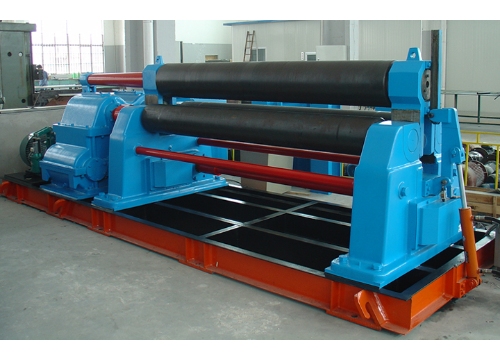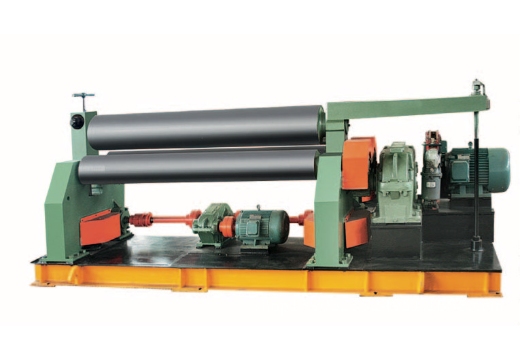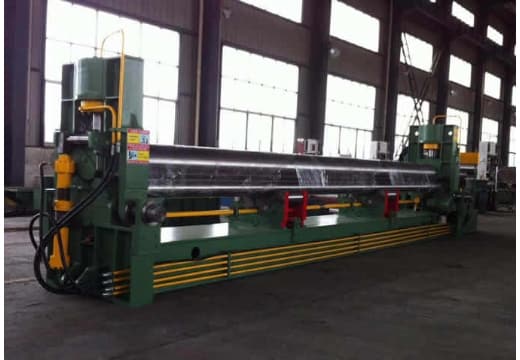A world of difference! The distinction between three-roll and four-roll plate bending machines
The Difference Between Three-Roll and Four-Roll Plate Bending Machines
A plate rolling machine is a common forging press equipment capable of bending non-metallic plates into conical,spherical,cylindrical,or other shapes.This functionality finds extensive application across industries such as manufacturing,boiler steam systems,chemical engineering,non-metallic structures,and machinery fabrication.Due to varying operational requirements,plate rolling machines are categorised by the number of rolls they employ,primarily into three-roll and four-roll types.Many assume that the distinction between three-roll and four-roll plate rolling machines is merely the addition of one roll,with no other significant differences.Consequently,some purchasers opt for four-roll machines based on the notion that an extra roll equates to enhanced functionality.However, this perception is erroneous,as substantial differences exist between the two.
Shape and appearance
Three-roll plate bending machines feature three rolls,while four-roll plate bending machines possess four rolls.Beyond this most obvious distinction,three-roll machines exhibit a relatively simpler appearance,prioritising straightforward functionality. Four-roll machines,being hydraulically controlled and numerically operated,present a more refined and aesthetically pleasing exterior with meticulous attention to detail,meeting higher standards for machining precision and operational comfort.
Machine structure
Mechanical three-roll plate bending machines are further categorised into symmetrical three-roll plate bending machines and asymmetrical three-roll plate bending machines.The symmetrical three-roll plate bending machine features one roll positioned above and two rolls below,arranged symmetrically.The asymmetrical three-roll plate bending machine,conversely,has two rolls on one side and one roll on the other, forming an asymmetrical configuration. The distinction from four-roll plate bending machines lies in the drive mechanism:the upper roll serves as the primary drive,connected via a reduction gearbox and cross-slide coupling to deliver torque for plate bending.The lower roll performs vertical lifting motion,achieved through a reduction gearbox,worm gear (or bevel gear) and lead screw assembly,enabling plate clamping via mechanical transmission.Side rolls are positioned on either side of the lower roll,moving at an angle along the frame guide rails via a lead screw and nut,or worm gear (or bevel gear) transmission.The four-roll plate bending machine features two rolls each at the top and bottom,with all four working rolls employing dynamic bearings.This difference in roll configuration results in distinct step mechanisms between three-roll and four-roll plate bending machines.
Processing type
The three-roll plate bending machine can form metal plates into circular or curved shapes.Its rollers move vertically up and down in a symmetrical position between the two lower rolls,driven by a lead screw and nut worm gear transmission.The two lower rolls rotate,powered by an electric motor.Torque for plate rolling is provided by the output gear of the reduction gearbox meshing with the lower roll gear.Plate ends require pre-bending using other equipment.The four-roll plate bending machine is suitable for bending and forming metal plates,capable of rolling circular,curved,and conical workpieces within a certain range.It features plate end pre-bending functionality,produces minimal residual straight edges,and can perform rough levelling of metal plates.
Degree of automation
The three-roll plate bending machine features simple button controls,while the four-roll version incorporates a touchscreen with a programmable CNC system.Digital control enables single-pass forming,with the touchscreen supporting visual input,step editing,and storage for 500 sets of data.The EPS electronic balancing system maintains roller parallelism within 0.15mm.Supports human-machine dialogue,fault self-diagnosis,and intelligent detection of operational errors.Drum-shaped roll shafts ensure excellent roundness and high straightness during rolling.All movements are hydraulically driven,with side rolls moving linearly within guide rails.The compact centre distance between side rolls achieves precise rolling accuracy.The robust,integral frame accommodates medium to large-scale rolling requirements.The frame undergoes full annealing to eliminate residual stresses,ensuring permanent dimensional stability.Roll shafts are forged as single components and undergo quenching and tempering hardening processes.Compatible with both manual and automatic operating modes.
Unloading method
The three-roll plate bending machine employs manual unloading,requiring operators to remove processed workpieces by hand. In contrast,the four-roll plate bending machine features button-operated control,enabling swift and convenient unloading.This offers a significant advantage over the three-roll model in terms of operational efficiency.
Roller motion type
Three-roll asymmetric plate bending machine,with the upper roll serving as the primary drive.The lower roll performs vertical lifting motion to clamp the plate,while simultaneously engaging with the upper roll gear to function as the main transmission.The side rolls execute tilting and lifting movements,providing dual capabilities for pre-bending and full-circle rolling.Three-roll symmetrical plate rolling machine:The upper roll performs vertical lifting motion at the symmetrical centre position between the two lower rolls,achieved through lead screw-nut and worm gear transmission.The two lower rolls rotate,engaging with the output gear of the reduction gearbox via the lower roll gear to provide torque for plate rolling.Their operating principles are identical,utilising the three-point circle principle for rolling different radii.However, the four-roll plate bending machine delivers superior performance in pre-bending straight edges and achieving circular accuracy compared to the three-roll plate bending machine.
Power configuration
The majority of three-roll plate bending machines are mechanical types,though hydraulic variants do exist;however,all four-roll plate bending machines are hydraulic.The mechanical three-roll symmetrical plate rolling machine adopts a symmetrical three-roll configuration.The upper roll,positioned symmetrically between the two lower rolls,performs vertical lifting motion via bevel gear transmission.The final-stage gear of the main reduction gearbox drives the meshing gears of the two lower rolls to rotate,providing the torque required for plate rolling.Flat, dimensionally accurate plastic metal plates pass between the machine's three working rolls (two lower rolls and one upper roll).Utilising the downward pressure of the upper roll and the rotational movement of the lower rolls,the metal plate undergoes multiple passes of continuous bending.This induces permanent plastic deformation,forming it into the required cylinder,conical cylinder,or a section thereof.A drawback of mechanical three-roll plate bending machines is that the plate ends require pre-bending using other equipment.The hydraulic three-roll symmetrical plate rolling machine adopts a symmetrical three-roll configuration.The upper roll,positioned centrally between the two lower rolls,performs vertical lifting motion via hydraulic fluid acting on the piston within the hydraulic cylinder.The final-stage gear of the main reduction gearbox drives the meshing gears of the two lower rolls to rotate,providing the torque required for plate rolling.Flat,dimensionally accurate plastic metal plates pass between the machine's three working rolls (two lower rolls and one upper roll).Through the downward pressure of the upper roll and the rotational movement of the lower rolls,the metal plate undergoes multiple passes of continuous bending.This induces permanent plastic deformation,forming it into the required cylindrical,conical,or partial sections.A drawback of the hydraulic three-roll symmetrical plate rolling machine is that the plate ends require pre-bending using other equipment.This machine is suitable for large-scale rolling of plates exceeding 50mm thickness.An additional row of fixed support rolls is added beneath the two lower rolls,reducing their span and thereby enhancing workpiece rolling precision and overall machine performance.The four-roll plate rolling machine is a hydraulic type.The upper roll serves as the primary drive,with torque for rolling provided by the output gear of the reduction gearbox meshing with the upper roll gear.The lower roll performs vertical lifting motion, achieved through hydraulic fluid acting upon the piston within the hydraulic cylinder to clamp the plate,constituting a hydraulic transmission system.Side rolls are positioned on either side of the lower roll,moving along the frame guide rails via a tilting motion driven by a lead screw and nut, or worm gear transmission.A key advantage of this machine is its capability to perform both end pre-bending and full-circle rolling on the same equipment.
Work efficiency
Three-roll plate bending machines,being predominantly mechanical in design,exhibit relatively low processing efficiency due to their motors and the necessity for manual intervention in numerous stages,resulting in comparatively low overall productivity.In contrast,four-roll plate bending machines,being hydraulic and CNC-controlled,feature high-efficiency motors,thereby achieving significantly greater overall productivity and substantially higher workpiece output rates than their three-roll counterparts.
machining accuracy
Three-roll plate bending machines offer adequate machining precision,meeting the fundamental requirements of most factories;four-roll plate bending machines provide higher machining precision and can also produce special shapes such as cones.
Price Comparison
For the same model,the price of a three-roll plate bending machine will inevitably be lower than that of a four-roll plate bending machine,as the former exhibits both lower precision and reduced operational efficiency compared to the latter.Should the machine be used infrequently and the precision requirements for workpieces be modest,the more economical three-roll plate bending machine may suffice.However,where higher product standards are demanded,the four-roll plate bending machine offers superior value for money and is therefore more highly recommended.
Understanding Purchasing
Rolling machines come in numerous models,each with distinct structural characteristics and performance capabilities.Prospective buyers must thoroughly understand the differences between these various types to avoid purchasing based on misconceptions.Otherwise,the acquired rolling machine may not only fail to meet operational requirements and deliver optimal performance but also introduce significant complications to the workflow.
 A world of difference! The distinction between three-roll and four-roll plate bending machines
A world of difference! The distinction between three-roll and four-roll plate bending machines
 Working Principle and Structural Features of the Top-Roll Universal Plate Bending Machine
Working Principle and Structural Features of the Top-Roll Universal Plate Bending Machine
 The primary functions of a plate rolling machine
The primary functions of a plate rolling machine

